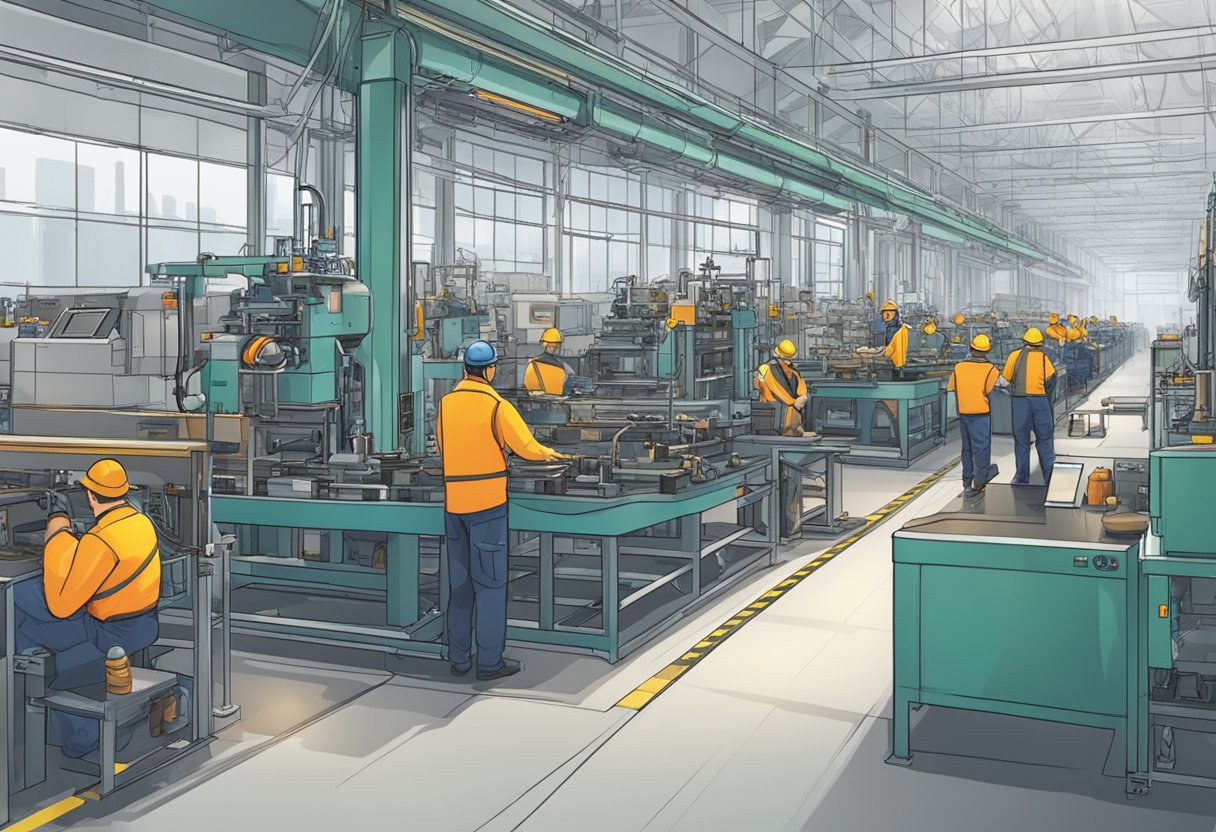Getting a product manufactured can be a daunting task, especially for those who are new to the industry. However, with the right approach and knowledge, it can be a smooth and successful process. The first step is to research and develop a clear understanding of the product, its intended use, and target audience. This will help in identifying potential manufacturers and suppliers who can meet the specific needs of the product.
Once the research is complete, the next step is to create a prototype of the product. This will help in testing and refining the design before it goes into production. Depending on the complexity of the product, it may be necessary to engage the services of a professional designer or engineer to create the prototype. A well-designed prototype can also help in attracting potential investors and manufacturers.
After the prototype is complete, the next step is to find a manufacturer who can produce the product at a reasonable cost while maintaining quality standards. This can be done by contacting manufacturers directly or through the use of online directories and platforms. It is important to vet potential manufacturers thoroughly and ask for samples and references before entering into any agreements. By following these steps, anyone can successfully get their product manufactured and ready for the market.
Understanding Product Manufacturing
Product manufacturing is the process of transforming raw materials into finished goods that are ready for sale. This process involves a series of steps that are designed to ensure that the product meets the required quality standards, is produced efficiently, and is cost-effective.
Manufacturers are the companies that specialize in product manufacturing. They are responsible for producing a wide range of goods, from consumer electronics to food products. They employ a variety of techniques and technologies to produce goods efficiently and cost-effectively.
The manufacturing process typically involves several stages, including design, prototyping, testing, and production. The design stage involves creating a blueprint or plan for the product. This stage is critical because it determines the product’s features, functionality, and overall quality.
Once the design is complete, the manufacturer will create a prototype of the product. This prototype is used to test the product’s functionality and to identify any issues that need to be addressed before production begins.
During the testing stage, the manufacturer will test the product to ensure that it meets the required quality standards. This may involve testing the product’s durability, performance, and safety.
Once the testing is complete, the product is ready for production. The manufacturing process involves a series of steps, including sourcing raw materials, assembling components, and packaging the finished product.
Entrepreneurs who are interested in product manufacturing should consider the following factors:
- Cost: Product manufacturing can be expensive, so entrepreneurs should carefully consider the costs involved in each stage of the process.
- Quality: The quality of the product is critical to its success. Entrepreneurs should work with manufacturers who have a reputation for producing high-quality goods.
- Timeframe: The manufacturing process can take several months or even years. Entrepreneurs should plan accordingly and be prepared for potential delays.
In summary, product manufacturing is a complex process that requires careful planning, attention to detail, and a commitment to quality. Entrepreneurs who are interested in product manufacturing should work with experienced manufacturers who can guide them through each stage of the process.
Researching Your Options
When it comes to manufacturing a product, researching your options is crucial to finding the right manufacturer. Here are some sub-sections to consider when researching your options:
Domestic Vs. Overseas Manufacturing
One of the first decisions to make is whether to manufacture domestically or overseas. Domestic manufacturing offers several advantages such as faster turnaround times, better quality control, and easier communication. However, it can be more expensive than overseas manufacturing. Overseas manufacturing, particularly in China and other Asian countries, can be cheaper but it comes with its own set of challenges such as language barriers, longer lead times, and quality control issues.
Online Platforms and Directories
Online platforms and directories such as Google, Alibaba, ThomasNet, MFG, Maker’s Row, Kompass, and Oberlo can be useful tools for finding manufacturers. These platforms allow you to search for manufacturers by location, product type, and other criteria. They also provide reviews and ratings from other users, which can help you make an informed decision.
Trade Shows and Referrals
Attending trade shows and getting referrals from other businesses can also be effective ways to find manufacturers. Trade shows provide an opportunity to meet with manufacturers in person and see their products firsthand. Referrals from other businesses can also be valuable because they have already done the research and vetting process.
Global Sourcing
Global sourcing involves finding manufacturers in different countries and regions around the world. This approach can be useful for finding manufacturers with specialized expertise or unique materials. However, it also comes with challenges such as language barriers, cultural differences, and logistics.
Trading Companies Vs. Wholesalers
When researching manufacturers, it’s important to understand the difference between trading companies and wholesalers. Trading companies act as intermediaries between manufacturers and buyers, while wholesalers buy products in bulk and sell them directly to retailers or consumers. Trading companies can be useful for finding manufacturers and negotiating prices, but they can also add an extra layer of cost. Wholesalers can be useful for buying products in bulk at a lower cost, but they may not offer as much customization or quality control.
In conclusion, researching your options is a crucial step in finding the right manufacturer for your product. By considering factors such as domestic vs. overseas manufacturing, online platforms and directories, trade shows and referrals, global sourcing, and trading companies vs. wholesalers, you can make an informed decision that meets your business needs.
Developing Your Product Idea
Developing a new product idea can be an exciting and challenging process. In order to turn your idea into a successful product that meets the needs of your target market, you need to follow a few key steps. This section will cover the essential steps involved in developing your product idea, including concept and design, prototyping, market research, branding, and intellectual property protection.
Concept and Design
The first step in developing a new product is to come up with a concept. This can involve brainstorming, researching existing products, and identifying gaps in the market. Once you have a concept, you need to develop a design that meets the needs of your target market and is feasible to manufacture. This can involve sketching, 3D modeling, and working with a product design firm.
Prototyping
Once you have a design, the next step is to create a prototype. This can involve 3D printing, CNC machining, or other rapid prototyping techniques. Prototyping allows you to test your design and identify any issues that need to be addressed before moving on to manufacturing.
Market Research
Before you start manufacturing your product, it’s important to conduct market research to ensure there is demand for your product. This can involve surveying potential customers, analyzing industry trends, and researching your competition. By understanding your target market and their needs, you can ensure that your product will be successful.
Branding and Intellectual Property Protection
Once you have a product that is ready for manufacturing, it’s important to develop a strong brand and protect your intellectual property. This can involve creating a trademark, patent, or copyright, as well as signing a non-disclosure agreement (NDA) to protect your confidential information.
In conclusion, developing a new product idea requires careful planning and execution. By following these essential steps, you can turn your product idea into a successful new product that meets the needs of your target market.
Choosing a Manufacturing Partner

Choosing the right manufacturing partner is crucial in ensuring that the product is manufactured to the desired quality standards. The manufacturing partner should be selected based on factors like quality, quality control, due diligence, communication, and language.
Quality is one of the most important factors to consider when selecting a manufacturing partner. The manufacturing partner should have a proven track record of producing high-quality products. The quality of the product can be ensured by conducting quality checks at every stage of the production process.
Quality control is another important factor to consider when selecting a manufacturing partner. The manufacturing partner should have a robust quality control system in place to ensure that the product meets the desired quality standards. The quality control system should cover all aspects of the production process, from raw material sourcing to final product inspection.
Due diligence is also important when selecting a manufacturing partner. The manufacturing partner should be thoroughly vetted to ensure that they have the necessary experience, expertise, and resources to produce the product to the desired quality standards. Due diligence should cover aspects like financial stability, production capacity, and legal compliance.
Communication is another important factor to consider when selecting a manufacturing partner. The manufacturing partner should be able to communicate effectively and clearly in the language that the product owner is comfortable with. This is especially important when working with overseas manufacturing partners where language barriers can be a challenge.
In conclusion, selecting the right manufacturing partner is critical to the success of the product. The manufacturing partner should be selected based on factors like quality, quality control, due diligence, communication, and language. By doing so, the product owner can ensure that the product is manufactured to the desired quality standards.
Negotiating Terms and Costs

When it comes to getting a product manufactured, negotiating terms and costs with the manufacturer is a crucial step. This can be a complex process, but it’s important to ensure that all parties are clear about expectations and responsibilities. Here are some key areas to focus on when negotiating terms and costs.
Minimum Order Quantity and Payment Terms
One of the most important terms to negotiate is the minimum order quantity (MOQ). This is the minimum number of units that the manufacturer will produce for you. MOQs can vary widely depending on the product and the manufacturer, so it’s important to negotiate a quantity that works for both parties.
Payment terms are also an important consideration. Be clear about your budget and payment requirements, and negotiate terms that work for both parties. This may include payment in installments, payment upon delivery, or other arrangements.
Shipping Costs and Turnaround Time
Shipping costs can be a significant expense when manufacturing products. Negotiate shipping costs with the manufacturer to ensure that you are getting the best deal possible. You can also negotiate turnaround time, which is the amount of time it takes for the manufacturer to produce and ship your product. Be sure to negotiate a realistic turnaround time that meets your needs.
Sample Pricing and Product Specification
Before committing to a manufacturer, it’s important to get samples of your product to ensure that it meets your specifications. Negotiate sample pricing with the manufacturer to ensure that you are getting a fair price. You should also negotiate the product specification, which includes details such as materials, dimensions, and packaging. Be clear about your expectations and negotiate terms that work for both parties.
Overall, negotiating terms and costs with a manufacturer is an important step in the manufacturing process. By being clear about your expectations and negotiating terms that work for both parties, you can ensure a cost-effective and successful manufacturing process.
Launching Your Product

Once your product is manufactured, it’s time to launch it into the market. This section will cover some important aspects of launching your product like sales and marketing, ecommerce and selling online, inventory and scale, and customs and regulations.
Sales and Marketing
To make your product launch successful, you need to have a solid sales and marketing plan. This includes identifying your target audience, creating a marketing message that resonates with them, and selecting the right channels to reach them. You can use social media, email marketing, influencer marketing, and advertising to reach your target audience.
Ecommerce and Selling Online
In today’s digital age, ecommerce is an essential part of any product launch strategy. You can use platforms like Amazon, Etsy, and Shopify to sell your products online. You need to optimize your product listings, provide excellent customer service, and use digital marketing techniques to drive traffic to your ecommerce store.
Inventory and Scale
As your product gains popularity, you need to ensure that you have enough inventory to meet demand. You can use a just-in-time inventory system to minimize inventory costs. You can also work with a third-party logistics provider to manage your inventory and shipping.
Customs and Regulations
When you’re selling products internationally, you need to comply with customs and regulations. You need to ensure that your product meets the safety and quality standards of the target market. You can work with a customs broker to navigate the complex customs regulations and ensure that your products are delivered on time.
Launching a product can be a complex process, but with the right strategy and execution, you can make it a success. By focusing on sales and marketing, ecommerce, inventory and scale, and customs and regulations, you can launch your product with confidence.


